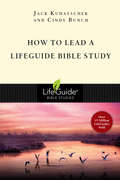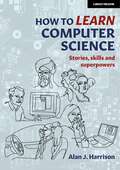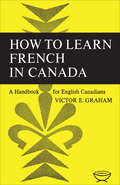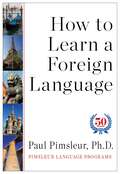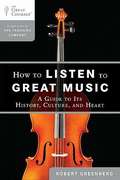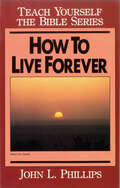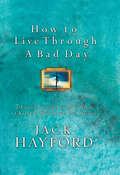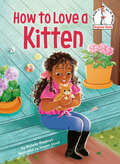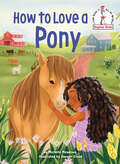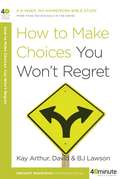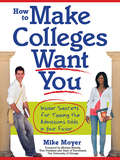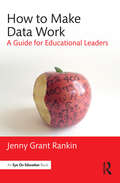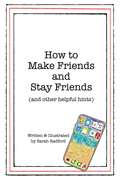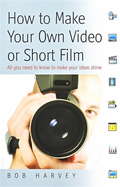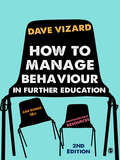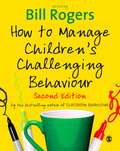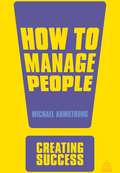- Table View
- List View
How to Lead a Life of Crime
by Kirsten MillerA meth dealer. A prostitute. A serial killer. Anywhere else, they'd be vermin. At the Mandel Academy, they're called prodigies. The most exclusive school in New York City has been training young criminals for over a century. Only the most ruthless students are allowed to graduate. The rest disappear. Flick, a teenage pickpocket, has risen to the top of his class. But then Mandel recruits a fierce new competitor who also happens to be Flick's old flame. They've been told only one of them will make it out of the Mandel Academy. Will they find a way to save each other--or will the school destroy them both?
How to Lead a LifeGuide® Bible Study (LifeGuide Bible Studies)
by Jack Kuhatschek Cindy Bunchhow to start a grouphow to decide what to studyhow to prepare to leadhow to study the Biblehow to use a study guidehow to write your own questionshow to lead the discussionhow to evaluate the study
How to Learn Computer Science: Stories, skills and superpowers
by Alan J. HarrisonHow To Learn Computer Science is for all ambitious students of computer science. Reading this book will illuminate the subject, explaining where each topic comes from, looking at its history and exploring links to wider culture. The book tackles some key stumbling blocks in each topic such as common misconceptions: mistaken ideas about the topic that slow you down and cause frustration. Plenty of 'fertile questions' prompt you to think hard about the topic, and each chapter encourages you to 'Stretch It' by trying some ambitious activities, 'Link It' to other topics and 'Build It' in the form of a practical project. You will also find links to helpful resources and further reading for greater depth, and some super study skills that will help you achieve a top grade.Read this book for a top grade in Computer Science!Alan Harrison is head of computing at a school in Manchester. He is a Computing at School master teacher and community leader, a National Centre for Computing Education training facilitator and a Raspberry Pi Foundation content author. @mraharrisoncs
How to Learn Computer Science: Stories, skills and superpowers
by Alan J. HarrisonHow To Learn Computer Science is for all ambitious students of computer science. Reading this book will illuminate the subject, explaining where each topic comes from, looking at its history and exploring links to wider culture. The book tackles some key stumbling blocks in each topic such as common misconceptions: mistaken ideas about the topic that slow you down and cause frustration. Plenty of 'fertile questions' prompt you to think hard about the topic, and each chapter encourages you to 'Stretch It' by trying some ambitious activities, 'Link It' to other topics and 'Build It' in the form of a practical project. You will also find links to helpful resources and further reading for greater depth, and some super study skills that will help you achieve a top grade.Read this book for a top grade in Computer Science!Alan Harrison is head of computing at a school in Manchester. He is a Computing at School master teacher and community leader, a National Centre for Computing Education training facilitator and a Raspberry Pi Foundation content author. @mraharrisoncs
How to Learn French in Canada: A Handbook for English Canadians
by Victor E GrahamIt is well known that even after several years' exposure to high-school French, most English Canadians remain unable to speak the language. It is equally well known that many French Canadians are bilingual. One of the more obvious explanations for this relative deficiency on the part of the English Canadian is his lack of opportunities to use the French language in day-to-day situations, and, conversely, the French Canadian's need to know the second language, too often perhaps for economic reasons. Professor Graham's book gives useful and practical suggestions on how to go about becoming fluent in French. It offers not a course of instruction, but a listing of practical ways of applying oneself to a study of the language. There is specific, up-to-date information and advice regarding services provided by the governments of Quebec and France, courses offered in various Canadian communities, clubs and societies, correspondence courses, universities and summer schools, and language laboratories. A feature which will be especially helpful for those in remote areas is the listing of publications (books, newspapers, and periodicals), music and songs, records, films, and radio and television programmes which provide instruction in French. The reader will quickly see that the available means are much more varied than he realizes, and it is in providing this concise, convenient enumeration of them that Professor Graham performs a great service. Any adult who is reasonably proficient in French, but wishes to improve, will find this a practical and useful guide to ways of making a personal contribution to bilingualism in Canada. This study has been prepared under the sponsorship of the Canadian Association for Adult Education.
How to Learn a Foreign Language
by PimsleurIn this entertaining and groundbreaking book, Dr. Paul Pimsleur, creator of the renowned Pimsleur Method, the world leader in audio-based language learning, shows how anyone can learn to speak a foreign language.If learning a language in high school left you bruised, with a sense that there was no way you can learn another language, How to Learn a Foreign Language will restore your sense of hope. In simple, straightforward terms, Dr. Pimsleur will help you learn grammar (seamlessly), vocabulary, and how to practice pronunciation (and come out sounding like a native). The key is the simplicity and directness of Pimsleur’s approach to a daunting subject, breaking it down piece by piece, demystifying the process along the way. Dr. Pimsleur draws on his own language learning trials and tribulations offering practical advice for overcoming the obstacles so many of us face.Originally published in 1980, How to Learn a Foreign Language is now available on the 50th anniversary of Dr. Pimsleur’s publication of the first of his first audio courses that embodied the concepts and methods found here. It's a fascinating glimpse into the inner workings of the mind of this amazing pioneer of language learning.
How to Learn and Practice Science
by A. R. PrasannaThis book is a small but practical summary of how one can and should learn science. The author argues that science cannot be taught but has to be learnt. Based on historical examples he shows that practicing science means putting one’s intellect into the understanding of simple questions like what, why, how and when events around you happen. The reader understands that the search for the cause and effect relationship of so called normal happenings is a very provocative experience and learning science leads one to it. This is underpinned by looking at everyday experiences and how they can help any lay-person learn science. The author also explains the methodology of science and discusses an integrated approach to science communication. Finally he elaborates on the influence and role of science in society. The book addresses interested general readers, teachers and science communicators.
How to Listen to Great Music
by Robert GreenbergThis course can permanently enrich your life in a way that few other experiences can rival: with Professor Robert Greenberg as your teacher, you will suddenly be able to hear and understand an entire language of unmatched beauty, genius, and power. We make strong claims for this course. When you are finished, so will you. Professor Greenberg will provide you with an outstanding grasp of musical forms, techniques, and terms-the "grammatical" elements that make you fluent in the "language" of music. And he will teach about the powerful influence of social context on musical creation. Best-selling author James Collins, writing in Inc. magazine, explains: "The Greenberg series combines a history of western civilization with a history of great music from ancient Greece to the 20th century. Greenberg's 48 lectures come alive with passion and knowledge. The course illustrates the interplay between societal change and innovation, and offers a unique perspective on the acceleration of change wrought by the 20th century. " Using digitally recorded musical passages to illustrate his points, the dynamic Professor Greenberg will take you inside magnificent compositions by Bach, Handel, Haydn, Mozart, Beethoven, Chopin, Verdi, Wagner, Brahms, Tchaikovsky, Stravinsky, and more.
How to Live Forever- Teach Yourself the Bible Series (Teach Yourself the Bible)
by John PhillipsThe Teach Yourself the Bible Series is one of the best New Testament studies you will find anywhere. Each book in the series is packed full of valuable questions on individual chapters of the Bible, check-ups to test your grasp of scriptural truths, and usable suggestions for group study.Grow in your knowledge of God through each New Testament book, then go on to study six aspects of Christianity essential for all believers: doctrine, prayer, eternal life, prophecy, Christian character, and Bible study.Eternal life is a gift from God. How to Live Forever is a step-by-step study of the nature of our God, who has provided for everyone the opportunity for eternal life. Learn the reasoning behind accepting God's gift.Strengthen your relationship with the living God with all twenty-five books of the Teach Yourself the Bible Series. Each volume is a timeless, yet practical, study of the Word of God.
How to Live Through A Bad Day: 7 Encouraging Insights from Christ's Words on the Cross
by Jack HayfordEach of us has experienced bad days, and these bad days are often compounded by our focus on the "badness" of the situation. But Dr. Jack Hayford contends that," in such times the Lord calls us to hear His voice." And so, beginning with seven phrases uttered by Jesus on the cross, he constructs the model for godly behavior while enduring hardship. Insights include: Father, forgive them for they know not what they do. To forgive those seeking to injure you is to remove yourself from their control.My God, my God, why have you forsaken Me? We can ask God the hard questions.Into Your hands I commit My spirit. Surrender your suffering to God and let go.How to Live Through a Bad Day is ideal for anyone who has experienced stress, pain, weariness, or an assault of character. Jack Hayford speaks the words of Jesus -- the words of life that sustain and encourage us to live through our worst days.
How to Love a Kitten (Beginner Books(R))
by Michelle MeadowsIn this charming rhymed Beginner Book follow-up to How to Love a Pony—a girl finds a lost cat and her kittens on her family farm, and learns to care for them while looking for their owner. A perfect choice for animal-lovers learing to read!On a sunny day at her family's horse farm, seven-year-old Lily makes an enchanting discovery under the farmhouse porch: a mother cat and her adorable kittens! With her family by her side and some guidance from a caring veterinarian, Lily takes on the heartwarming mission of caring for the little feline family. As she searches for their rightful owner, she not only finds a new friend but learns invaluable lessons about love, responsibility, and the pure joy of unexpected friendships. Dive into this beautifully illustrated tale, and you might just find yourself reading it again and again!Beginner Books are fun, funny, and easy to read! Launched by Dr. Seuss in 1957 with the publication of The Cat in the Hat, this beloved early reader series motivates children to read on their own by using simple words with illustrations that give clues to their meaning. Featuring a combination of kid appeal, supportive vocabulary, and bright, cheerful art, Beginner Books will encourage a love of reading in children ages 3–7.
How to Love a Pony (Beginner Books(R))
by Michelle MeadowsA rhymed Beginner Book about a young girl and her pony, perfect for animal-lovers and budding equestrians!Meet Lily, a seven-year-old girl who lives with her parents, grandparents, and two brothers on their horse farm in the country. Lily has a Welsh pony that she adores, and in this charming Beginner Book, we see how Lily and her family work together to care for the pony throughout the changing seasons of the year. With vibrant illustrations, this is the kind of story that young riders—or kids who dream of riding—will want to read over and over!Originally created by Dr. Seuss himself, Beginner Books are fun and easy to read. These unjacketed hardcover early readers encourage children to read all on their own, using simple words and illustrations. Smaller than the classic large format Seuss picture books like The Lorax and Oh, The Places You&’ll Go!, these portable packages are perfect for practicing readers ages 3-7, and lucky parents, too!
How to Make Choices You Won't Regret (40-Minute Bible Studies)
by Kay Arthur David Lawson B J LawsonHow to make choices now that you won’t regret later. You may be wondering how you ended up where you are, whether your life would have been better if you had made different decisions along the way. Or maybe your current situation is great, but you’re facing some difficult choices. God wants to help you. Every day you and I are faced with innumerable decisions, some of which have the potential to change the course of our lives forever. Certain avenues open to us are marked with hidden pitfalls or lead in harmful directions. And in some instances the wrong choice can even bring death. Where do you go for direction? What do you do when faced with temptation? How do you decide what choices to make? This study answers those questions by exploring the role of Scripture and the Holy Spirit in the process, as well as examining the decision-making of people such as David, Josiah, Eve, and Jesus. As a result, my friend, I pray you will be equipped to make choices that bring honor to God and peace to your heart. --Kay Arthur The 40-Minute Bible Studies tackle vital issues in short, easy-to-grasp lessons for personal or group use–with no homework required.
How to Make Collaboration Work: Powerful Ways to Build Consensus, Solve Problems, and Make Decisions
by David StrausEvery day we must work with others to solve problems and make decisions. Yet these efforts at collaboration often leave us frustrated, angry and exhausted, and end up taking too much time.
How to Make Colleges Want You
by Mike Moyer<p><b>What if you had colleges coming after you instead of the other way around? </b></p><p>The hidden little secret of college admissions is that most schools are desperate. . . desperate for great kids who do things differently and will make their campuses vibrant and exciting. </p><p>And you don't have to be an A student, the president of your student body, or the winner of the national spelling bee to do this. Any student can become someone that colleges compete for if you follow the recommendations in this book. </p><ul><li><b>The Secret of NTAs: </b>Unusual activities that make you stand out</li><li><b>Breaking the Zone: </b>Take advantage of where you're from and who you are</li><li><b>Striking the Nerve:</b>Decode what colleges believe in, then match those values</li><li><b>Your Application Team:</b>Getting references, teachers, and counselors to boost your odd<br>And much more</li></ul><p>No matter where you are in your high school career, you can start these things today and vastly increase your odds of getting into the competitive college of your choice. </p>
How to Make Data Work: A Guide for Educational Leaders
by Jenny Grant RankinEducators are increasingly responsible for using data to improve teaching and learning in their schools. This helpful guide provides leaders with simple steps for facilitating accurate analysis and interpretation of data, while avoiding common errors and pitfalls. How to Make Data Work provides clear strategies for getting data into workable shape and creating an environment that supports understanding, analysis, and successful use of data, no matter what data system or educational technology tools are in place in your district. This accessible resource makes data easy to understand and use so that educators can better evaluate and maximize their systems to help their staff, students, and school succeed. With this tried-and-true guidance, you’ll be prepared to advocate for tools that adhere to data reporting standards, avoid misinterpretation of data, and improve the data use climate in your school.
How to Make Friends and Stay Friends: (and other helpful hints)
by Sarah RadfordHave you ever been in a restaurant and heard raucous noises coming from a table full of children next to you? Or perhaps those children were yours and their behaviour made you want to crawl under the table in embarrassment? Well, this book is for you!For years I have closely studied children and their behaviour. I’ve witnessed the thrill of victory and the agony of defeat. Navigating the world can be difficult. Making friends, learning how to share and play nicely do not always come naturally. These are learned behaviours and in order for a child to understand and perform them they must first be taught them.With this book’s help children will learn the value and the many skills required for:-effective listening-communicating diplomatically-maintaining healthy boundaries-making new friends-attending social events-understanding and appreciating others-achieving and maintaining emotional well-being-winning favour with peersThere are also chapters in this book dedicated to classroom etiquette, the importance of a smile, how to not drive your parents crazy on a long car ride and so much more!At the end of the day we all hope the best for the next generation. We want them to be happy and successful; financially, socially and emotionally. However, in order for them to be comfortable and to thrive in any situation, they need to know how to conduct themselves in a polite, thoughtful and loving manner.The aim of this book is to give young people the skills they need to manage life’s challenges and to treat others the way that they would like to be treated.
How to Make Hand-Drawn Maps: A Creative Guide with Tips, Tricks, and Projects
by Helen CannWith wonderful examples and easy-to-follow instructions, this beautifully illustrated how-to book makes it simple and fun to create one-of-a-kind hand-drawn maps. Helpful templates, grids, and guidelines complement a detailed breakdown of essential cartographic elements and profiles of talented international map artists. From city maps and family trees to treasure maps, palmistry charts, platformgame maps, and more, the wide range of projects collected here will satisfy first-time cartographers as well as veteran mapmakers inspired by the popular map art trend.
How to Make Partner and Still Have a Life: The Smart Way to Get to and Stay at the Top
by Jo Larbie Heather TownsendThe burning question on every ambitious fee-earner's lips is: 'how do I make partner at this firm?' Fully updated with the latest insights to tackle all the most current challenges in this fast developing industry, this 2nd edition of How to Make Partner and Still Have a Life is your route map to making it to the top in a professional services firm. It shows you how to stand out, be in the right place at the right time and build your kitbag of skills to overcome the many hurdles and reach the Holy Grail of becoming partner. This book reveals what it really takes to make it, and what it will involve once you're there. It helps you make an informed decision on whether or not this is the right step for you, and guides you on how to become a partner and still sustain a healthy work/life balance. Heather Townsend and Jo Larbie show you the rules of the game, laying bare exactly what you need to do to take the ultimate step.
How to Make Partner and Still Have a Life: The Smart Way to Get to and Stay at the Top (Kogan Page Ser.)
by Jo Larbie Heather TownsendBecoming a partner in a professional services firm is for many ambitious fee-earners the ultimate goal. But in this challenging industry, with long hours, high pressure and even higher expectations, how do you stand out from the crowd? How do you build the most effective relationships? And how do you find the time to do all of this and still have a fulfilling personal life? Now in its third edition, How to Make Partner and Still Have a Life equips individuals at the start of their career through to partner with the skills needed to reach and succeed at the leadership level.How to Make Partner and Still Have a Life details the expectations and realities of being a partner and outlines how you can continue to achieve once you have obtained the much-coveted role. This edition is updated with guidance on developing the right mindset for success and the importance of mentoring and sponsorship. There is a specific focus on women and BAME professionals and the challenges faced by individuals coming from non-traditional or under-represented backgrounds. Heather Townsend and Jo Larbie provide a guide to help you tackle common obstacles and work smarter - not harder - to reach the top. Start your journey to partnership and still have the time for a life outside of work.
How to Make Your Own Video or Short Film: All you need to know to make your ideas shine
by Bob HarveyNew technologies now offer accessibility to the medium of video and film for virtually anyone who feels they have something to say. You might be: someone who wants to create a video to share online; someone who wants to record and document everyday events that happen around you; a charity worker wanting to highlight the plight of the less fortunate, or a journalist keen to use film to explore social issues; an artist or a writer eager to experiment within an an audio visual medium; anyone who wants to step into a world of discovery and challenge, and learn new skills along the way.This book offers an abundance of hints, tips and practical advice that will help emerging film-makers discover an exciting form of expression, either for personal satisfaction or to make their mark in a highly competitive industry. It includes: deciding what kind of film you want to make; choosing a camera; choosing your subject matter; dealing with copyright; using music to enhance your film; working with professional actors; researching information and avoiding location problems; production meetings; budgets; schedules; conducting interviews for documentaries; digital editing; aound and lighting techniques; and, making your film stand out from the crowd.
How to Make Your Own Video or Short Film: All You Need To Know To Make Your Ideas Shine
by Bob HarveyNew technologies now offer accessibility to the medium of video and film for virtually anyone who feels they have something to say. You might be: someone who wants to create a video to share online; someone who wants to record and document everyday events that happen around you; a charity worker wanting to highlight the plight of the less fortunate, or a journalist keen to use film to explore social issues; an artist or a writer eager to experiment within an an audio visual medium; anyone who wants to step into a world of discovery and challenge, and learn new skills along the way.This book offers an abundance of hints, tips and practical advice that will help emerging film-makers discover an exciting form of expression, either for personal satisfaction or to make their mark in a highly competitive industry. It includes: deciding what kind of film you want to make; choosing a camera; choosing your subject matter; dealing with copyright; using music to enhance your film; working with professional actors; researching information and avoiding location problems; production meetings; budgets; schedules; conducting interviews for documentaries; digital editing; aound and lighting techniques; and, making your film stand out from the crowd.
How to Manage Behaviour in Further Education
by Dave Vizard′Dave Vizard presents a wealth of sound techniques to promote positive behaviour as well as how to respond to learners who are both troubled and troublesome in a college setting...a must for those who daily face challenging behaviours as well as those who offer advice and support′- Rob Long, Behaviour Specialist and Project Worker Packed with advice, ideas and staff development activities, this practical book provides everything you need to manage difficult behaviour and create a positive learning environment in Further Education settings. New to this second edition: - advice on dealing with mobile phones in lectures - supporting students experiencing cyber-bullying - dealing with gang culture - managing confrontations between students and lecturers - how to re-engage disaffected learners - working with learners from a diverse range of backgrounds - supporting additional needs - using the right sort of language - managing difficult groups, and adult groups - examples from prisons and work-based learning situations - reflective activities Ideal for lecturers, teachers and support staff working with young people and adults in Further Education, everything in the book has been tried and tested by the author. Dave Vizard is an independent consultant and trainer on behaviour management who has worked with hundreds of colleges and schools on improving student behaviour.
How to Manage Children's Challenging Behaviour
by Bill RogersA new edition of this book is available `All royalties from the sale of this book are donated to the charity World Vision for children's education programmes in South East Asia'. All teachers face similar issues of behaviour, from calling out, interrupting, inappropriate loudness, through to more disturbing bullying, violence and behaviour disorders. This book addresses the issue of challenging behaviour and behaviour disorders in schools. It shows how teachers - in a supportive team - have made a significant difference to their students in terms of behaviour, attitude, self-esteem and peer acceptance. Bill Rogers sets out the key principles of behaviour leadership drawn from the teachers' own accounts. Teachers spend a third of their working day with children. Their goodwill, energy and patience are sometimes stretched to the limit by some of the children they are called on to teach, manage and support. Some of the children we read of in this book are children whose family situation does not always support what schools seek to be and to do. There are sometimes disturbing reasons why these children are disruptive. But the teachers in this book never 're-victimise' the child. They know that behaviour is developed and learned, in context. Bill Rogers is a respected education consultant who travels frequently to the United Kingdom from Australia, to conduct INSET and seminars with schools and universities in the areas of behaviour management; discipline; effective teaching; stress management and teacher welfare. Bill's work is well known for his emphasis on practical approaches and skills, as well as his sensitivity to teachers' needs and concerns. How to Manage Children's Challenging Behaviour is essential reading for practising teachers at any level.
How to Manage People
by Michael ArmstrongFrom Michael Armstrong, HR expert and best-selling author, comes this new edition of the business staple, How to Manage People. Providing valuable insight into the functions and skills required to be an effective manager - from how to manage teams to successful recruitment - it will help you get the best from your staff through motivation, reward and leadership. With three brand new chapters on managing virtual teams, enhancing employee engagement and managing conflict, it is full of easily applicable advice as well as practical tools and checklists. Essential reading for anyone who wants to get the best from their teams, How to Manage People distils the essence of good management into one handy book.

